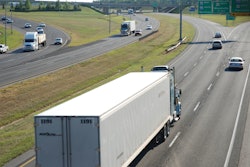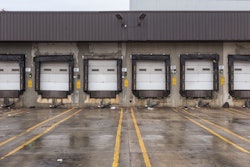According to the latest report from the Bureau of Transportation Statistics, total transborder freight in North America was up 7.5% in February over the same month a year ago. That was driven by a 4.4% increase in freight between U.S. and Canada, and a 10.6% increase in U.S.-Mexico freight.
Of the $128.9 billion of transborder freight moved in February across all modes, trucking moved by far the largest portion of that -- $83.4 billion.
Ryan Williams, vice president of solutions and head of cross-border at Coyote Logistics, joins us this week on The 10-44 to talk about what his company is seeing and how it’s handling the influx of cross-border freight.
Contents of this video
00:00 10-44 intro
00:31 Bureau of Transportation Statistics
01:15 Coyote Logistics
03:16 Nearshoring
06:41 U.S.-Mexico freight
08:36 Expanding operations into Mexico
11:02 U.S.-Canada freight
Jason Cannon:
CCJ's 10-44 is brought to you by Chevron Delo Heavy-Duty Diesel Engine Oil. Now there's even more reasons to choose Delo.
Matt Cole:
The amount of cross-border freight between the US and Canada and the US and Mexico is on the rise. What's driving that trend?
Jason Cannon:
You're watching CCJ's 10-44. A weekly webisode that brings you the latest trucking industry news and updates from the editors of CCJ. Don't forget to subscribe and hit the bell for notifications, so you'll never miss an installment of 10-44.
Hey, everybody. Welcome back. I'm Jason Cannon and my co-host, as always, on the other side is Matt Cole. According to the latest report from the Bureau of Transportation Statistics, total trans-border freight in North America was up about 7.5% in February over the same month a year ago. That was driven by a 4.4% increase in freight between the US and Canada, and a 10.6% increase between the US and Mexico.
Matt Cole:
Of the $128.9 billion of trans-border freight moved in February across all modes, trucking moved by far the largest portion of that, 83.4 billion. Ryan Williams, Vice President of Solutions and Head of Cross-border at Coyote Logistics, joins us this week to talk about what his company is seeing and how it's handling the influx of cross-border freight.
Ryan Williams:
So Coyote, I think, traditionally, is probably known more as a US based 3PL and brokerage. My background is maybe a little bit different in that sense, where I was heavily involved in the UPS side of things pre and post acquisition. I actually moved over to Europe and was there running our operations for three years. I've been back in the US and focusing on cross-border now for three years, cross-border specifically, for about a year. But in terms of our background, particularly on the southern border, we've had an office and a team set up in Guadalajara since 2016, which in terms of just experience and a differentiator on our side, the expertise there and the fact that we've been there as long as we have, is certainly something that we leverage. A lot of the people that we still have on the team, the team's right around 150 people now and have been around for five plus years. So really since that inception, which is obviously great in terms of how we can leverage that and what the experience looks like there.
But yeah, in terms of the freight that we move and what our focus is on both borders, it's pretty balanced on the northern border in terms of what we look at both northbound and southbound. Intra Canada is a fairly small piece that we're looking to grow, but in terms of that balance, that's something that's a little bit more manageable on the north side. In terms of the southern border, things still do and probably will continue to skew heavier northbound. If you look at the import export data, that's obviously growing from an import standpoint, given I think, a lot of the news that people are familiar with, with Mexico now being the US's largest trade partner. But in terms of how that continues to evolve, I think it's something where obviously, people are bullish on what that looks like in the future, and I think how you manage that from both a shipper and carrier standpoint is something that I think is still evolving and people are getting their feet under them in terms of what that looks like.
So I think what we offer there is just certainly, consultative components that can help with that, but also that background and experience from a capacity standpoint, from a shipper knowledge standpoint that we've just been around as long as we have been in that market.
Jason Cannon:
Ryan says there was a shift in how a lot of cross-border freight was handled during the Covid pandemic that shippers have preferred to stick around.
Ryan Williams:
Nearshoring's that big buzzword that I think everybody's familiar with at this point. I think there's an article almost every day where you see that pop up, right? So I think in terms of what we're seeing and how that's impacted things, particularly since Covid, I think a lot has changed because of that in terms of how companies are managing their freight and how carriers are reacting accordingly. I think we've seen a lot more shippers interested in carriers that can provide that through trailer door-to-door service that was maybe more conducive to the marketplace during Covid, but also, is maybe less touch than a transload would be at the border. I think in terms of the freight flows themselves, they're obviously changing and will continue to change as manufacturing and factory openings continue to push closer to the border. You're seeing that length of haul decrease. You're seeing the lanes that you're really focusing on changing, and I think that's something that'll continue to kind of evolve as we go here.
So I think it's something that's worth keeping a pulse on current state, but also, as you plan future state, really what does that look like? What are those ports of entry you're focused on? What are the lanes going to look like that may change from shippers that you're working with on a consistent basis as time goes on? So I really think that collaborative approach across both parties and the necessity of oftentimes having somebody in the middle coordinating a lot of that, particularly from a border perspective, is going to be even more important than it has been.
Matt Cole:
As Ryan mentioned, Mexico has become the United States' biggest trade partner. Ryan explains why that's happened and what he sees going forward after a quick word from 10-44 sponsor Chevron lubricants.
Speaker 4:
These past few years have been less than easy. We've encountered challenges we never imagined we'd ever have to deal with. From makeshift home offices and video meetings, to global supply chain uncertainty, price instability, market disruptions, and everything in between. Delivering the level of services and products our customers had come to expect was difficult for all of us. We can't change what's behind us, but we can definitely learn from it. We can adapt, evolve, and take steps to reset our thinking, adapt our strategies, and restore your trust in us to better meet your needs, now and in the future.
That change begins today. Today we break with convention and introduce a rebalanced line of Delo heavy duty engine oils. We've reduced our product line from four categories to two. Consolidated and simplified, this lineup removes complexity from the manufacturing processes, enhancing price stability and supply chain reliability so you can trust you'll have the premium products you need to keep your business always moving forward. Our break with convention optimizes the Delo lineup to allow you to provide your customers with the best synthetic blend and synthetic heavy-duty engine oils in the market, fully available at prices you can rely on. It's your assurance that you'll be well-positioned to be their trusted source for proven engine protection that keeps equipment on the job, giving your customers even more reasons to choose Delo.
Ryan Williams:
If you look at the segmentation of companies that are moving into Mexico or expanding their operations, it's very automotive heavy, it's very IT heavy, electronics heavy. It's a lot of those companies that did look at moving their origin points in Asia and manufacturing in Asia, and then really how they get their freight back into the US. So I think in terms of the growth component there, a lot of that's going to continue to be driven by those segments, and there's obviously specialization tied into those segments and how a lot of those customers want their freight moved. So in terms of what you look at from a capacity allocation standpoint, you have to be conscious of that specialization. There's a lot more variables that go into particularly, the southern border and the freight moving into the US in that regard. So I think we're continuing to see new requirements that pop up in accordance with a lot of that freight.
So I think just being on top of that and also a lot of the governmental regulations that are continuing to change and evolve as time goes on, only becomes more important. So in general, a lot of that, it ties back into I think the inbound component and whether it's raw materials or finished product. I think we saw two of the west coast ports in Mexico as the only two in North America that grew in 2023 and will continue to do so. So what does the infrastructure and capacity look like for drayage? What does it look like in terms of getting freight into those larger hubs within Mexico? And you kind of think about that triangle between Mexico City, Monterey and Guadalajara. That's where a lot of that capacity is aggregated. So you have a lot of the drayage companies that are pulling freight from those ports into those areas or directly to the border. What does that look like a year from now? What does that look like five years from now? Likely completely different than it does today.
So again, it's kind of keeping a pulse on that and what that looks like and ultimately, how that fits into your planning from a shipper perspective or from a carrier perspective.
Jason Cannon:
With more freight coming across the border, more opportunities are available for US based carriers that are looking to expand their operations.
Ryan Williams:
A lot more of those southern border based carriers that we've worked with traditionally are now a lot more interested in expanding their operations into Mexico because it does link up so well and especially from that transload perspective with northbound freight, there is such heavy reliance on rates in the US and that piece from the border inland that really having that holistic view on things is really important for them, for us as well, and ultimately, for the shipper base. So I think, in terms of what we've seen there is just obviously increased interest in expanding that and what that looks like outside of just the US piece that maybe we were more heavily focused on in the past. Now it's really just how can we kind of get that A to Z view of what the shipment is doing or what the product's doing from its origin point, whether that's in Asia or otherwise, into Mexico, into the US.
I think there's variable ways of approaching that, maybe more so than there had been in the past, both in terms of the truckload piece and then increased in our model offerings now spanning through the US and into Canada. There's a lot more options out there, and I think leveraging that optionality is something that's good for everybody and just making sure that obviously, there's an option on the table that works best for that specific load, that specific freight, whatever it may be.
I think the main thing right now that especially this year and really as of April 1 that's come into play, is the additional layer of the Complemento Carta Porte, which is for U.S. carriers very similar to a kind of expanded and more detailed BOL. So the necessity of having those for shipments crossing is becoming significantly more important than it was previously. Carriers are very conscious with the fines that are associated with that if that's not provided by a shipper. So really, the first portion of this year has been working through that with our shipper and carrier base just to make sure there's as much consistency and education as possible tied into that.
There definitely were variable approaches in terms of what shippers were doing to comply with that, at least to start the year, but with that becoming a lot more rigid as time goes on here, and really as of April 1, I think, in terms of what that looks like for carriers, it's just something to be conscious of and something that I think we're particularly conscious of making sure everybody on our end is aware of and kind of who is responsible for what pieces there.
Matt Cole:
Looking to the North, Ryan says US Canada Freight has been stable in recent times.
Ryan Williams:
It's been pretty stable. I think we saw, especially last year, it was a really stable year coming out of '22 when we saw things, I guess, progress in the manner that was pretty reflective of the US market. But in terms of what that looks like, at least to start this year, the import piece is down about 3%. The export piece is a little bit more, but really, for last year, it was roughly flat, a bit up in terms of imports. In terms of what we see there, and it's really just been the status quo. I think we do see some West Coast influence from a nearshoring standpoint and shippers conscious of bringing stuff into the port of Vancouver or whatever it may be on that side of things. But in terms of the evolution of what that looks like, it's definitely different than the southern border.
I think for us, it's really been focusing on expanding maybe our LTL offerings, our final mile offerings, where we can on top of the truckload piece that again, we've had and moved for a decade plus now since really probably the inception of Coyote. So I think that one's a little bit more projectable in terms of how, again, you procure and how you allocate capacity to the freight that you have available. So I do think it is something that'll always continue to evolve, there'll always be components that influence that. I think there you see a lot of, not necessarily natural disasters, but weather events that impact things. There's more in that sense that I think is on the table on a consistent basis than maybe we see in Mexico, but it's definitely been a more stable environment, especially over the past 12 or so months here.
Jason Cannon:
That's it for this week's 10-44. You can read more on CCJDigital.com while you're there. Sign up for our newsletter and stay up to date on the latest in trucking industry news and trends. If you have any questions or feedback, please let us know in the comments below. Don't forget to subscribe and hit the bell for notifications so you can catch us again next week.










